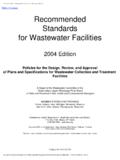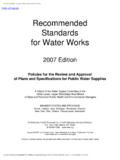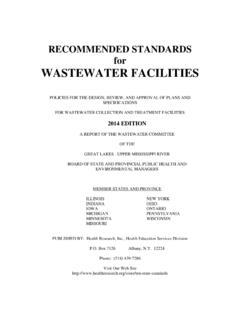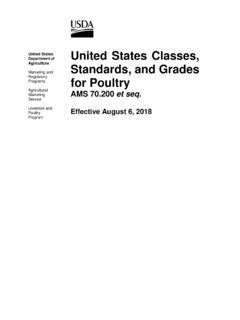Transcription of A Guide to United States Footwear Compliance Requirements
1 NISTIR 8116. A Guide to United States Footwear Compliance Requirements NISTIR 8116. A Guide to United States Footwear Compliance Requirements Lisa M. Benson Karen Reczek This publication is available free of charge from: NISTIR 8116. A Guide to United States Footwear Compliance Requirements Lisa M. Benson*. Karen Reczek standards Coordination Office * Dakota Consulting This publication is available free of charge from: March 2012. Revised April 2016. Department of Commerce Penny Pritzker, Secretary National Institute of standards and Technology Willie May, Under Secretary of Commerce for standards and Technology and Director Acknowledgements The lead author for this document is Lisa M. Benson, Dakota Consulting, under contract to the standards Coordination Office of NIST. Additional guidance, initial research, and review of the document were provided by the staff of the standards Coordination Office of NIST including: Mary Donaldson and Karen Reczek.
2 Invaluable support was also received from the knowledgeable experts at the Consumer Product Safety Commission and the Federal Trade Commission who provided input into the document and also conducted a thorough review. Consumer Product Safety Commission reviewers were Patty Edwards and Arlene Flecha Castro. Federal Trade Commission reviewers were Steve Ecklund and Robert Frisby. This publication is available free of charge from: Table of Contents HOW TO USE THIS Guide .. 1. SCOPE .. 1. OVERVIEW OF FEDERAL REGULATORY FRAMEWORK .. 1. FEDERAL REGULATORY AUTHORITIES AND TECHNICAL REGULATIONS (MANDATORY).. 2. Consumer Product Safety Commission (CPSC) .. 2. Consumer Product Safety Act .. 2. Consumer Product Safety Improvement Act of 2008 (CPSIA).. 2. Children's Footwear Only .. 2. This publication is available free of charge from: Tracking Labels for Children's Footwear .. 3. Certificates and Mandatory Third-Party Testing.
3 3. Federal Hazardous Substances Act (FHSA) .. 3. Sharp Points and Edges on Children's Products .. 4. Flammability of 4. Pending Regulations of Note .. 5. Customs and Border Protection (CBP) .. 5. Marking Of Imported Articles and Containers .. 5. Environmental Protection Agency (EPA) .. 5. Toxic Substance Control Act (TCSA) .. 6. Federal Trade Commission (FTC) .. 6. Federal Trade Commission Act (FTC Act) .. 6. Leather and Imitation Leather Guide .. 7. Fur Products Labeling Act .. 7. Truth in Fur Labeling Act of 2010 .. 7. The Wool Products Labeling Act of 1939 .. 8. Tariff Act of 1930, Prohibition on Importation of Dog and Cat Fur Products .. 8. Environmental Claims .. 9. Occupational Safety and Health Administration (OSHA) .. 9. Occupational Safety and Health Act Of 1970 (OSH Act) .. 9. United States Department of Agriculture (USDA).. 10. Organic Fibers: Organic Foods Production Act of 1990 (OFPA).
4 10. OVERVIEW OF STATE REGULATORY FRAMEWORKS .. 11. STATE REGULATORY AUTHORITIES AND TECHNICAL REGULATIONS (MANDATORY) .. 11. Packaging and Labeling .. 11. UPLR .. 11. Toxics in Packaging Legislation .. 12. State of California .. 12. Lead and Other Toxic Substances .. 12. Safer Consumer Products Regulations .. 12. Made in the USA .. 13. State of Illinois .. 13. 13. This publication is available free of charge from: State of Minnesota .. 14. Formaldehyde in Children's Products .. 14. State of Washington .. 14. Lead, Cadmium, and Phthalates in Children's 14. Multiple States .. 14. Flame Retardant Regulations .. 14. Chemicals of Concern .. 14. Felt Sole Waders and Boots .. 15. OVERVIEW OF THE VOLUNTARY standards FRAMEWORK .. 15. standards DEVELOPING ORGANIZATIONS (SDOS) .. 15. ASTM International .. 15. TESTING AND CERTIFICATION BODIES .. 16. Testing .. 16. Certification .. 16. RELEVANT GOVERNMENT AGENCIES.
5 17. Customs and Border Protection (CBP) .. 17. Consumer Product Safety Commission (CPSC) .. 17. Occupational Safety and Health Administration (OSHA) .. 17. Environmental Protection Agency (EPA) .. 17. Federal Trade Commission .. 18. Department of Agriculture .. 18. Footwear INDUSTRY AND MARKET DATA .. 18. Trade Associations .. 18. Footwear Market Data .. 19. A Guide to United States Footwear Compliance Requirements HOW TO USE THIS Guide . Regulations are mandatory standards are voluntary (unless Incorporated by Reference in a regulation). Guidelines may be voluntary (but are often de facto industry standards ). Red text highlights mandatory Requirements Blue text indicates a hyperlink to a website, page or document on the web This publication is available free of charge from: SCOPE. This Guide addresses general purpose Footwear (made of leather, fur, and man-made materials). and protective Footwear (for use in the workplace).
6 OVERVIEW OF FEDERAL REGULATORY FRAMEWORK. Once a law has been enacted by Congress, the appropriate federal agency ( , the Consumer Product Safety Commission, the Federal Trade Commission, the National Highway Traffic and Safety Administration, et al.) may create the regulations to implement the law. Before such regulations can be adopted, the appropriate federal agency ordinarily will issue a notice of proposed rulemaking (NPRM) to solicit public comments on the proposed rules.. To provide opportunity for public comment, the appropriate federal agency must issue draft regulations or Proposed Rules that are published in the Federal Register and as a WTO TBT notification. The agency reviews the comments and can then issue a Final Rule that also is published in the Federal Register, and later, published annually in the Code of Federal Regulations (CFR). Together, the enabling acts/laws [published in the United States Code (USC) once passed] and the final regulations (published in the Code of Federal Regulations) provide a framework for the implementation and enforcement of most federal laws in the United States .
7 Page | 1. FEDERAL REGULATORY AUTHORITIES AND TECHNICAL REGULATIONS (MANDATORY). Several federal agencies administer regulations associated with Footwear . Agency Scope Consumer Product Safety Commission (CPSC) Children's Footwear ; hazardous substances Customs and Border Protection (CBP) Country of origin for most imported products Federal Trade Commission (FTC) Labeling Occupational Health and Safety Protective Footwear Administration (OSHA). United States Department of Agriculture Organic claims (USDA). This publication is available free of charge from: Note: Textile fiber identification and labeling are not required for Footwear , unlike for apparel. Consumer Product Safety Commission (CPSC). Consumer Product Safety Act Title 15, United States Code, Chapter 47, Sections 2051-2089. The Consumer Product Safety Act, entered into law on October 27, 1972, was enacted to establish the Consumer Product Safety Commission and define its authority with the purpose of protecting the public against unreasonable risks of injury associated with consumer products.
8 Assisting consumers in evaluating the comparative safety of consumer products, developing uniform safety standards for consumer products; and promoting research and investigation into the causes and prevention of product-related deaths, illnesses, and injuries. Consumer Product Safety Improvement Act of 2008 (CPSIA). Public Law 110 314, August 14, 2008. On August 14, 2008, the President signed into law Public Law 110-314 (Consumer Product Safety Improvement Act of 2008). On August 12, 2011, he signed into law amendments to the Act, Public Law 112 28, August 12, 2011. The Act provided CPSC with significant new regulatory and enforcement tools as part of amending and enhancing several CPSC statutes, including the Consumer Product Safety Act. Children's Footwear Only The Consumer Product Safety Improvement Act (CPSIA) enacted in 2008 regulates specific substances in children's products including children's Footwear .
9 The CPSIA sets limits for lead content and phthalates in children's products. A children's product is defined as a consumer product designed or intended primarily for children age 12 years or younger. With respect to children's Footwear , Section 101(a) of the CPSIA restricts children's products, including children's Footwear , and components of children's Footwear , to a lead content limit Page | 2. of 100 parts per million (ppm.) In addition, the use of paint or similar surface coating on children's shoes must not exceed 90 ppm. The CPSC recently revised 16 CFR (d)(7) to clarify that the Commission has determined that textiles that have treatments and applications consisting entirely of dyes do not exceed the lead content limits and are not subject to the third party testing Requirements for children's products, so long as those materials have not been treated or adulterated with materials that could add lead.
10 Tracking Labels for Children's Footwear Tracking labels are required for all products that are designed and intended primarily for children ages 12 and younger, including children's Footwear . The tracking label must be affixed to the product (to the extent practical) and packaging, visible, legible, and provide certain basic identifying information, including: This publication is available free of charge from: Manufacturer or private labeler name;. Location and date of production of the product;. Detailed information on the manufacturing process, such as a batch or run number, or other identifying characteristics; and Any other information to facilitate ascertaining the specific source of the product. For more detailed information, see CPSC's: Tracking Label Requirements for Children's Products Certificates and Mandatory Third-Party Testing Section 102 of the CPSIA requires every manufacturer or importer of all consumer products that are subject to a consumer product safety rule enforced by the CPSC to issue a general certificate of conformity based on testing the product and stating that the product complies with the applicable standard, regulation, or ban.















